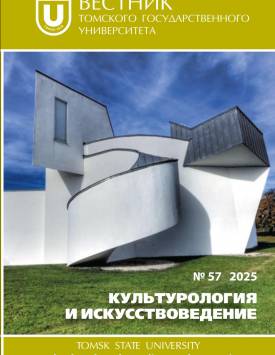Neo-pagan ideologies in the fine arts of modern Russia
The article is aimed to highlight the types of religious ideologies that exist in two forms of Russian neo-paganism (Slavic and Finno-Ugric), and to consider the reflection of these types in the fine arts of contemporary artists. The author relies on the socioconstructivist approach in understanding religion, uses comparative, typological and semiotic methods for studying ideological and artistic practices. Relying on existing research, the author presented an overview of the common features and trends of Slavic Rodnoverie and Finno-Ugric neo-paganism as forms of modern secular religiosity. An original typology of religious ideologies is proposed: religion is a function oriented towards the political and practical transformation of empirical reality; religion-gnosis, focused on the comprehension of meta-empirical reality; religion-symbol (or religion-culture), focused on the totality of religious symbols as an expression of ethno-cultural identity. In nationalist Rodnoverie, the position of religion-function dominates, in religious Rodnoverie - religion-gnosis, in Meryan ethnofuturism - religion-symbol. An analysis of the embodiment of neo-pagan themes and imagery in the works of fine art by Russian artists showed the existence of stable correspondence between the type of religious ideology and the formal and stylistic characteristics of paintings and drawings. The ideology of religion-function is reflected in the works of B. Olshansky, A. Shishkin, A. Klimenko, V. Korolkov, M. Kuleshov, I. Ozhiganov, V. Dzalba, A. Sinyakin, A. Timofeev and others. This group is characterized by figurativeness, anthropomorphism, appeal to the stylistic traditions of neoclassicism, national romanticism (modern), fantasy art. The ideology of religion-gnosis is reflected in the work of V. Vyatich, M. Sukharev; they are characterized by a rejection of figurativeness, ornamentality, an appeal to (pseudo)archaic and avant-garde, and experimentalism. The ideology of religion-symbol is characteristic of the artists of Finno-Ugric ethnofuturism (P. Mikushin, G. Fomiryakov, I. Fedosova, A. Malyshev and others), who combine figurativeness and abstract symbolism. The author declares no conflicts of interests.
Keywords
neo-paganism,
secular religiosity,
religious ideology,
native faith,
ethnofuturism,
visual arts,
meta-empirical reality,
gnosisAuthors
| Ivanov Andrei A. | Novosibirsk State Technical University; Russian Christian Humanitarian Academy | larsandr@mail.ru |
Всего: 1
References
Hanegraaff W.J. New Age Spiritualities as Secular Religion: a Historian's Perspective // Social Compass. 1999. Vol. 46, № 2. P. 145-160.
Гальцин Д.Д. Лики Протея: история современного язычества как религиозной идентичности. СПб.: Изд-во РХГА, 2020. 296 с.
Aitamurto K., Simpson S.Introduction. Modern Pagan and Native Faith Movements in Central and Eastern Europe // Modern Pagan and Native Faith Movements in Central and Eastern Europe / ed. by K. Aitamurto, S. Simpson. London: Routledge, 2014. P. 2-9.
Strmiska M.F. Pagan Politics in the 21st Century: "Peace and Love" or "Blood and Soil"? // The Pomegranate. 2018. № 20 (1). P. 5-44.
Клейн Л. С. Воскрешение Перуна: К реконструкции восточнославянского язычества. СПб.: Евразия, 2004. 480 с.
Кавыкин О.И. "Родноверы". Самоидентификация неоязычников в современной России. М.: Институт Африки РАН, 2007. 232 с.
Осинцев А.В. Русское неоязычество и миф о великом происхождении, прародине и языке // 30 лет кафедре религиоведения Уральского федерального университета: сб. науч. ст. Екатеринбург: Макс-Инфо, 2017. С. 211-223.
Шнирельман В.А. Русское родноверие. Неоязычество и национализм в современной России. М.: Изд-во ББИ, 2012. 302 с.
Айтамурто К. Родноверие, современное славянское язычество и сложности определения "религии" // Русское религиоведческое общество. 06.03.2019. URL: https://rro.org.ru/2019/03/k-ajtamurto-rodnoverie-sovremennoe-slavjanskoe-jazychestvo-i-slozhnosti-opredelenija-religii/(дата обращения: 15.06.2023).
Шнирельман В.А. Назад к язычеству? Триумфальное шествие неоязычества по просторам Евразии // Неоязычество на просторах Евразии / сост. В.А. Шнирельман. М.: ББИ св. апостола Андрея, 2001. С. 130-169.
Богатова О.А. "Повторное изобретение" и трансформация локальной религиозной традиции: эрзянский неоязыческий ритуал // Этнографическое обозрение. 2015. № 5. С. 33-50.
Knorre B. Neopaganism in the Mari El Republic // Modern Pagan and Native Faith Movements in Central and Eastern Europe / ed. by K. Aitamurto, S.Simpson. London: Routledge, 2014. P. 249-265.
Малышев А. Эндю Мерянь - Мерянский этнофутуризм // Merjamaa. URL: http://www.merjamaa.ru/news/merjanskij_ehtno_futurizm/2010-11-15-102 (дата обращения: 30.05.2023).
Мациевич И.В., Семедов С.А. Политические религии в современном мире // Вестник Института социологии. 2012. № 4. С. 36-49.
Альтюссер Л. Идеология и идеологические аппараты государства // Неприкосновенный запас. 2011. № 3 (77). URL: http://magazines.russ.ru/nz/2011/3/al3.html (дата обращения: 15.04.2023).
Верслуис А. Что такое эзотерика? Методы исследования западного эзотеризма // Государство, религия, церковь в России и за рубежом. 2013. № 4. С. 11-35.
Рыбинский В. Интервью с художником-космистом Василием Вятичем // Вестник культуры. 30.11.2020. № 22. URL: https://orpheus18.wixsite.com/vectnikkyltyri/2-василий-вятич (дата обращения: 30.05.2023).
Время мифов. Художник Максим Сухарев. Страница автора. URL: https://vk.com/mythtime (дата обращения: 30.05.2023).

